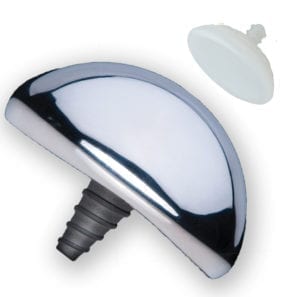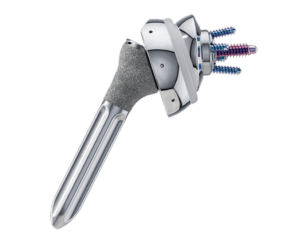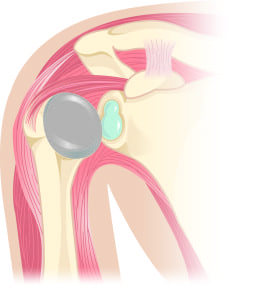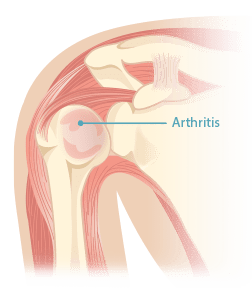Shoulder Implants
Anatomic Shoulder Implant Systems
Shoulder HemiCAP®, OVO®/OVOMotion® with Inlay Glenoid TSA Systems, & RevoMotion® Reverse Shoulder Arthroplasty System
Have you been told you may need a shoulder replacement? Arthrosurface’s joint preservation and restoration systems are designed to remove less bone than a traditional total shoulder replacement, preserve native anatomy, provide greater and more natural range of motion1, and ultimately allow patients to return to the active lifestyle they love.
Arthrosurface offers solutions for both a total shoulder replacement and a reverse shoulder replacement. Several minimally invasive alternatives to traditional total shoulder replacements include the Arthrosurface Shoulder HemiCAP System, the OVO Shoulder Arthroplasty System and the OVOMotion with Inlay Glenoid Total Shoulder Arthroplasty System. These implants provide bone and tissue sparing techniques and are designed to reduce pain, improve range of motion, and prevent further damage to the joint.


Our anatomic, stemless shoulder systems are designed with the patient in mind and include a range of options shown to be an effective treatment for joint conditions associated with all stages of glenohumeral osteoarthritis, avascular necrosis, Hill-Sachs lesions and post-traumatic degenerative disease. With options from a stemless partial shoulder implant (hemiarthroplasty) to total shoulder replacements, Arthrosurface’s shoulder systems address pain and support an anatomic repair, which allows patients to return to the activities they love.
If you have a large rotator cuff tear that requires a joint replacement, your surgeon may choose to use a reverse shoulder implant. A reverse shoulder “reverses” the ball and socket of your natural joint, allowing you better range of motion. Arthrosurface’s RevoMotion Reverse Shoulder System offers patients pain relief with an implant designed to precisely fit each patient’s anatomy.

Patient Benefits
- Implants are designed to precisely fit each patient’s natural anatomy
- Less bone removal, allowing for preservation of bone and soft tissues
- The procedure may be performed on an outpatient basis, inlcuding ambulatory surgery centers (ASCs)
Patient Benefits specific to Total Shoulder Replacement products
- Maintains existing joint biomechanics, thereby allowing normal motion
- Patients experience a rapid return to activity for both work and exercise
- Clinical studies demonstrate positive outcomes
- Patients report pain relief, rapid recovery, and full range of motion
If you are living with shoulder pain, speak to your doctor about Anika’s joint preservation implants today.
- Uribe JW, Zvijac JE, Porter DA, Saxena A, Vargas LA. Inlay total shoulder arthroplasty for primary glenohumeral arthritis. J Shoulder Elbow Surg International. 2021 5(6):1014-1020.
Why Does My Shoulder Hurt?
An Injury or disease process (i.e. inflammation) that damages the cartilage may cause arthritis. A small cartilage injury could eventually grow and lead to cartilage loss, degenerative joint disease, and troublesome neck and shoulder pain. A variety of injuries can also damage your cartilage or cause rotator cuff pain, including trauma (dislocation), infection and inflammation. A traumatic injury can cause an isolated defect, while continuous overuse can cause widespread damage to both sides of the joint and result in shoulder surgery.  Typically, as the “wear and tear” on the shoulder joint progresses, bone spurs (osteophytes) can form on top of the bones. These bone spurs can cause pain when the shoulder moves and can limit the motion of the joint. With time, the spurs become larger, the cartilage starts to wear away and the shoulder joint becomes stiff. In the shoulder, this condition is called Degenerative Joint Disease (DJD).
Typically, as the “wear and tear” on the shoulder joint progresses, bone spurs (osteophytes) can form on top of the bones. These bone spurs can cause pain when the shoulder moves and can limit the motion of the joint. With time, the spurs become larger, the cartilage starts to wear away and the shoulder joint becomes stiff. In the shoulder, this condition is called Degenerative Joint Disease (DJD).
Osteoarthritis
Osteoarthritis (OA) is a degenerative joint disease that affects the cartilage in your joint and is one of the most common causes of shoulder pain. OA can be caused by aging joints, injury, obesity, weightlifting, and/or high impact sports. As a degenerative joint disease that causes the cartilage in your joints to soften and break down, your joints will slowly become stiff and painful. When that layer of cartilage is damaged or worn away, your bones grind against one another causing lesions and shoulder pain that hurts. It may even keep you up at night. Osteoarthritis usually occurs in people over 50 years old, however, it’s possible for it to occur in younger people as well.
Osteonecrosis (AVN)
 This condition is translated as “bone death” (osteo=bone, necrosis=death). Also known as avascular necrosis or AVN (avascular = loss of blood supply). Osteonecrosis is caused by lack of blood supply to the bone, resulting in the deterioration of bone tissue and the collapse of the bone. It can be triggered by a variety of factors including trauma, alcohol abuse, genetic abnormalities, pregnancy, systemic disease or corticosteroids use from receiving medical treatment (e.g., cancer treatments and organ transplantation). However, in approximately 25% of patients the cause is still unknown.
This condition is translated as “bone death” (osteo=bone, necrosis=death). Also known as avascular necrosis or AVN (avascular = loss of blood supply). Osteonecrosis is caused by lack of blood supply to the bone, resulting in the deterioration of bone tissue and the collapse of the bone. It can be triggered by a variety of factors including trauma, alcohol abuse, genetic abnormalities, pregnancy, systemic disease or corticosteroids use from receiving medical treatment (e.g., cancer treatments and organ transplantation). However, in approximately 25% of patients the cause is still unknown.
Traumatic Lesions
The most common type of traumatic injury is known as a “Hillsachs Lesion.” This most often occurs when you dislocate your shoulder. A shoulder dislocation causes the head of the shoulder to chip off pieces of bone and can even break a piece of bone from the front edge of the glenoid. The chipping can result in a lesion on the back of the head and it usually causes a tear of the labrum (soft tissue bumper) on the front edge of the glenoid. When 30% or more of the head is chipped off, the Hillsachs lesion is sufficiently large enough to engage or catch on the front of the glenoid, causing discomfort. While not all Hillsachs lesions are painful, this catching can result in a sore shoulder and severely limit your motion. To stop this from happening again, the surgeon needs to fill the defect on the back of the head to keep it from catching. This can be accomplished by placing a HemiCAP® implant into the defect, restoring the shape of the humeral head and allowing it to articulate again without catching.
- No activity restrictions create an active alternative to shoulder replacement
- It is custom matched and fit to a patient’s joint size and shape
- Significantly less cartilage and bone is removed than traditional joint replacements
- It is placed into the surface of the bone rather than on top, leaving the joint less surgically altered, and native anatomy intact.
- Joint motion and the native structures are preserved so no bridges are burned for future revision options
With the Arthrosurface® Joint Restoration Systems, the surgeon only resurfaces the damaged area of the joint, similar to the way a dentist fills in a cavity. This leaves the rest of the structures in your joint intact so your native anatomy is preserved. The exposed and painful bone is covered while all the structures in your joint help you move and function properly are left in place. This differs from a total joint replacement which removes the entire head of the humerus, the rotator cuff and significant amounts of bone from the glenoid resulting in compromised supporting tissues. Because of the less invasive nature of this implant system, patients can expect shorter hospital stays, quicker recovery and the ability to live an independent active lifestyle following recovery.
Patients report outstanding pain relief, rapid recovery times and significant range of motion improvements in multi-center studies and the procedure may be performed on outpatient basis. Every surgery has risks and your prospects for a safe and successful surgery must be evaluated with your surgeon. If you are affected by osteonecrosis or cartilage damage caused by a previous injury, a successful joint restoration procedure may significantly improve your quality of life by reducing pain and restoring function. Many patients return to full activity after rehabilitation and go back to doing things that they had given up on in the years before surgery. After the surgical repair of a joint, your surgeon will provide you with specific post-operative instructions which you need to follow carefully. Post-operative rehabilitation recommendations will vary depending on the invasiveness of your surgery and your individual recovery patterns. The immediate focus in all surgeries will be on swelling and pain management. In some cases you may wear a brace for a few weeks and will be prescribed exercises and activities to strengthen your muscles. Here are a few helpful suggestions as you recover and rehabilitate from your surgery:
- Follow the recommendations of your surgeon and physical therapist.
- Keep a log to track your progress as you recover and increase activity.
- Ask for assistance from family and friends to help with chores and errands during your recovery.
- Wear loose, comfortable clothing during your recovery period.
- Eliminate possible tripping hazards in your home – wires, cables, rugs, etc.
- Return to any moderate or demanding activities should be guided by your tolerance for weight bearing.
Do you suffer from Shoulder Arthritis or pain and want to maintain and active or independent lifestyle? After trying non-operative treatments, such as steroid (cortisone) injections, physiotherapy, pain and anti-inflammatory medications, the pain relief is not receding. Now, the pain is serious enough that it is affecting your daily activities, your ability to work out and even your sleep. Most likely, you have been told that your next option is a total shoulder replacement but you don’t want a procedure that will restrict your active lifestyle.
- Want to regain your active lifestyle (crossfit, weightlifting, running, etc.)
- Want to live independently without restrictions (i.e. yard work, picking up grand kids, or children)
- You have had a microfracture treatment and/or injections, but the pain has returned
- You cannot afford lengthy rehabilitation time or excessive time off work
- You want to fix your shoulder problem now versus waiting for further damage
- Your surgeon has told you that you will need a traditional total shoulder replacement in the near future
*Seek professional medical advice for specific personal care.
